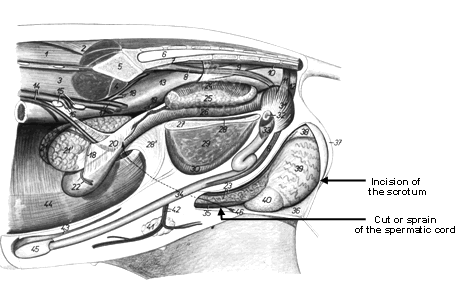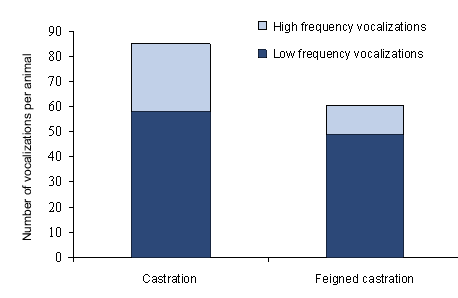Castration is currently performed surgically and without anesthesia during the first week of the animal’s life. This procedure involves the holding down and immobilization of the piglet, the incision of the scrotum with a scalpel, the exposition of the testis and the section or division of the spermatic cord (Figure 1). Although it is a rapid procedure (less than 30 s), it induces a series of physiological and behavioral changes in the piglet which are clearly indicative of pain and stress (Prunier et al., 2006).

In swine, high frequency vocalizations (>1000 Hz) are associated with pain. Taylor et al. (2001) compared the number of this type of vocalizations emitted by 3-, 10- and 17- day-old piglets when submitted to surgical castration or to a feigned castration (holding down and immobilization, but without being castrated). The castrated animals emitted a higher number of vocalizations than the non-castrated, and therefore suffered more pain (Figure 2). The number of vocalizations was higher in 10-day-old and 17-day-old piglets than in 3-day-old piglets, but this was both during the actual castration process as well as during the feigned castration. These data suggest that surgical castration without anesthesia is painful whatever the age, and that the higher number of vocalizations emitted by the animals of more than one week of age is due to their increased capacity for vocalizing rather than to a greater susceptibility to pain as had been suggested in the past. After castration, the ACTH and cortisol hormones, which are indicators of stress, increased by 40 and 3 times respectively above their basal concentration (Prunier et al., 2005). This physiological change is also indicative of pain and stress. Of the entire process, the most painful part is the exposition of the testis and the cutting of the spermatic cord.

Post-surgical pain can last for 5 days. In this time, the castrated piglets show signs of pain in the affected zone and they are less active. In the same way, playful behavior decreases as does activity around the mammary glands, whether sucking or massaging it for the following drink of milk. Surgical castration without anesthesia also has negative effects on the growth of the animal, its immune system and its health (EFSA, 2004).
Due to the fact that surgical castration without anesthesia causes pain and has negative effects on growth and the health of the animals, some European countries have already adopted measures to ban this practice. Norway banned castration of piglets in 2009, and since 2002 the use of anesthesia and analgesics during castration has been obligatory. Switzerland also banned surgical castration without anesthesia in 2009. The European Union is looking for alternatives to castration without anesthesia which eliminate the boar taint without causing the animal to suffer.




